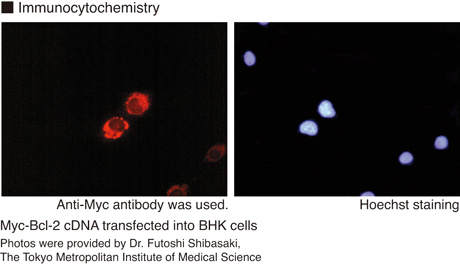- Japan(Japanese / English)
- Global
- MBL TOP
- MBL site search
Close
This site is for customers in Japan.
Customers in other regions, please go to Global page.
HOME >
Product search results > Code No. 562-5
Anti-Myc-tag pAb
Price
¥88,000
Availability (in Japan)
10 or more
(In Japan at 17:00,
Apr 20, 2024 in JST)
Size
500 µL
| Data | |||||
|---|---|---|---|---|---|
| Clonality | Polyclonal | Clone | Polyclonal | ||
| Isotype (Immunized Animal) | Rabbit IgG | ||||
| Applications | |||||
| Immunogen (Antigen) | synthetic peptide EQKLISEEDL (Myc-tag)-KLH | ||||
| Storage buffer | PBS/50% glycerol, pH 7.2 | ||||
| Storage temp. | -20°C | Conjugate | Unlabeled | Manufacturer | MBL |
| Background | Epitope tagging has widely been accepted technique that fuses an epitope peptide to a certain protein as a marker for gene expression. With this technique, the gene expression can be easily monitored on western blotting, immunoprecipitation and immunofluorescence utilizing with an antibody that recognizes such an epitope. Amino acid sequences that are widely used for the epitope tagging are as follow; YPYDVPDYA (HA-tag), EQKLISEEDL (Myc-tag) and YTDIEMNRLGK (VSV-G-tag), which corresponding to the partial peptide of Influenza hemagglutinin protein, Human c-myc gene product and Vesicular stomatitis virus glycoprotein respectively. | ||||
| Related products | 562 Anti-Myc-tag pAb M047-3 Anti-Myc-tag mAb M047-8 Anti-Myc-tag mAb-Agarose M047-10 Anti-Myc-tag mAb-Magnetic Agarose M047-A48 Anti-Myc-tag mAb-Alexa Fluor™ 488 M047-A59 Anti-Myc-tag mAb-Alexa Fluor™ 594 M047-A64 Anti-Myc-tag mAb-Alexa Fluor™ 647 M192-3 Anti-Myc-tag mAb M192-7 Anti-Myc-tag mAb-HRP-DirecT M047-11 Anti-Myc-tag mAb-Magnetic Beads M192-6 Anti-Myc-tag mAb-Biotin |
||||
| Citations |
Western Blotting
ChIP
Immunoprecipitation
Flow Cytometry
Immunocytochemistry
Immunohistochemistry
ELISA
|
||||
| Product category |
|
||||
- The availability is based on the information in Japan at 17:00, Apr 20, 2024 in JST.
- The special price is shown in red color.
- Please note that products cannot be ordered from this website. To purchase the items listed in this website, please contact us or local distributers.
- Abbreviations for applications:
WB: Western Blotting, IH: Immunohistochemistry, IC: Immunocytochemistry, IP: Immunoprecipitation
FCM: Flow Cytometry, NT: Neutralization, IF: Immunofluorescence, RIP: RNP Immunoprecipitation
ChIP: Chromatin Immunoprecipitation, CoIP: Co-Immunoprecipitation
DB: Dot Blotting, NB: Northern Blotting, RNA FISH: RNA Fluorescence in situ hybridization - For applications and reactivity:
*: The use is reported in a research article (Not tested by MBL). Please check the data sheet for detailed information.
**: The use is reported from the licenser (Under evaluation or not tested by MBL).
- For storage temparature: RT: room temparature
- Please note that products in this website might be changed or discontinued without notification in advance for quality improvement.














 Citations
Citations Data Sheet
Data Sheet


